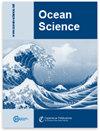非潮汐半封闭海盆中近期风暴潮表现形式的不确定性和差异:波罗的海后报组合
IF 3.3
3区 地球科学
Q2 METEOROLOGY & ATMOSPHERIC SCIENCES
引用次数: 2
摘要
摘要。极端海平面事件,如风暴潮,对全球海岸线构成威胁。几十年来,许多潮汐计一直在测量海平面并记录这些极端事件,有些甚至超过了一个世纪。来自这些测量仪的数据通常作为评估极端海平面统计数据的基础,这些统计数据用于推断海平面,作为海岸保护的设计值。水动力模型往往难以正确再现极端海平面,因此也难以准确再现极端海平面的统计数据和趋势。在本研究中,我们使用沿海海洋模式GETM(一般河口运输模式)生成了1979 - 2018年波罗的海非潮汐的13个成员的后置集合。为了处理模拟中最大水位的平均偏差,我们在集合中包括了有风速调节和没有风速调节的模拟。我们评估了极值统计和年最高海平面最近趋势的不确定性。尽管总体平均值与观测值在回归水平和趋势方面表现出良好的一致性,但我们仍然发现总体中存在很大的变异性和不确定性(30年回归水平的95%置信水平高达60厘米)。我们认为,大气再分析中的偏差和不确定性,例如风暴表现的变异性,直接转化为整体中的不确定性。将第99百分位风速的变率转化为海平面高度的变率与模拟的最高海平面的整体扩展的变率相同。我们的研究结果强调,13个成员是不够的,应该创建区域性的大集合以尽量减少不确定性。这将提高模式正确再现潜在极值统计数据的能力,从而提供对未来气候变化引起的变化的可靠估计。本文章由计算机程序翻译,如有差异,请以英文原文为准。
Uncertainties and discrepancies in the representation of recent storm surges in a non-tidal semi-enclosed basin: a hindcast ensemble for the Baltic Sea
Abstract. Extreme sea level events, such as storm surges, pose a threat to coastlines around the globe. Many tide gauges have been measuring the sea level and recording these extreme events for decades, some for over a century. The data from these gauges often serve as the basis for evaluating the extreme sea level statistics, which are used to extrapolate sea levels that serve as design values for coastal protection. Hydrodynamic models often have difficulty in correctly reproducing extreme sea levels and, consequently, extreme sea level statistics and trends. In this study, we generate a 13-member hindcast ensemble for the non-tidal Baltic Sea from 1979 to 2018 using the coastal ocean model GETM (General Estuarine Transport Model). In order to cope with mean biases in maximum water levels in the simulations, we include both simulations with and those without wind-speed adjustments in the ensemble. We evaluate the uncertainties in the extreme value statistics and recent trends of annual maximum sea levels. Although the ensemble mean shows good agreement with observations regarding return levels and trends, we still find large variability and uncertainty within the ensemble (95 % confidence levels up to 60 cm for the 30-year return level). We argue that biases and uncertainties in the atmospheric reanalyses, e.g. variability in the representation of storms, translate directly into uncertainty within the ensemble. The translation of the variability of the 99th percentile wind speeds into the sea level elevation is in the order of the variability of the ensemble spread of the modelled maximum sea levels. Our results emphasise that 13 members are insufficient and that regionally large ensembles should be created to minimise uncertainties. This should improve the ability of the models to correctly reproduce the underlying extreme value statistics and thus provide robust estimates of climate change-induced changes in the future.
求助全文
通过发布文献求助,成功后即可免费获取论文全文。
去求助
来源期刊

Ocean Science
地学-海洋学
CiteScore
5.90
自引率
6.20%
发文量
78
审稿时长
6-12 weeks
期刊介绍:
Ocean Science (OS) is a not-for-profit international open-access scientific journal dedicated to the publication and discussion of research articles, short communications, and review papers on all aspects of ocean science: experimental, theoretical, and laboratory. The primary objective is to publish a very high-quality scientific journal with free Internet-based access for researchers and other interested people throughout the world.
Electronic submission of articles is used to keep publication costs to a minimum. The costs will be covered by a moderate per-page charge paid by the authors. The peer-review process also makes use of the Internet. It includes an 8-week online discussion period with the original submitted manuscript and all comments. If accepted, the final revised paper will be published online.
Ocean Science covers the following fields: ocean physics (i.e. ocean structure, circulation, tides, and internal waves); ocean chemistry; biological oceanography; air–sea interactions; ocean models – physical, chemical, biological, and biochemical; coastal and shelf edge processes; paleooceanography.
 求助内容:
求助内容: 应助结果提醒方式:
应助结果提醒方式:


